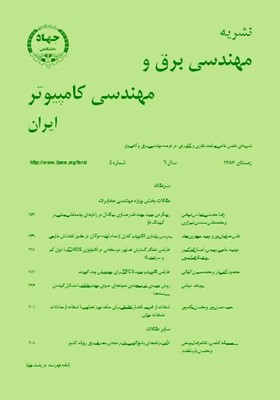ساختاری جديد برای محدود کننده جريان عيب
محورهای موضوعی : مهندسی برق و کامپیوترمهدی عباپور 1 , مهرداد طرفدارحق 2 , مهران صباحي 3
1 - دانشگاه تبريز
2 - دانشگاه تبريز
3 - دانشگاه تبريز
کلید واژه: محدودکننده جريان عيبراکتور غير فوق هادیافت ولتاژمدار جبرانکننده,
چکیده مقاله :
در اين مقاله ساختار جدیدي براي محدودكنندههاي جریان اتصال کوتاه پيشنهاد شده است. در محدودكننده پیشنهادی بهجاي استفاده از ابررسانا در ساخت سيمپيچ، از مس استفاده شده و تلفات سيمپيچي و همچنين تلفات ناشي از ادوات الكترونيك قدرت با استفاده از يك مدار كمكي جبران شده است. همانگونه كه نشان داده خواهد شد محدودكننده مذکور با كاركردي مناسبتر در زمان اتصال كوتاه، تأثیر بسيار کمتری بر مشخصههای سیستم در كاركرد عادي در مقايسه با آنچه كه تاكنون با استفاده از ابررسانا پيشنهاد شده بود از خود نشان ميدهد. امکان ساخت بدون نياز به تکنولوژی ابررسانا و عدم وجود مدار کنترل اصليترين مزاياي مدار پيشنهادي ميباشد. آناليز دقيق و مشخصههاي طراحي براي راكتور DC ارائهشده و شبیهسازیهای لازم با استفاده از نرمافزار PSCAD/EMTDC و براي نشاندادن عملكرد مناسب محدودكننده در جريانهاي اتصال كوتاه و عملكرد مناسبتر آن نسبت به نوع ابررسانا در كار عادي سيستم قدرت انجام شده است. نتایج آزمایشگاهی نيز بهدست آمده و تشابه آنها با نتایج شبیهسازی نشاندهنده کارآیی مناسب مدار جدید پیشنهادی برای محدودکردن جریان اتصال کوتاه میباشد.
In this paper a new structure for fault current limiter is proposed. In proposed structure the superconductor coil is replaced by a copper coil and the losses of copper coil and power electronic devices are compensated by an auxiliary circuit. The results show that the proposed structure has less undesired effect on normal operation of system compared with ordinary superconductor type. The main advantageous of proposed structure are no need to superconductor technology and its control-less operation. The analytical analysis and designing characteristics for DC reactor are presented. Also, the simulation and experimental results are presented to show the effectiveness of proposed structure in fault current limitation.
[1]E. Calixte, Y. Yokomizu, and T. Matsumura, "Theoretical evaluation of limiting resistance required for successful interruption in circuit breaker with fault current limiter," in Proc. of the 37th Annual North American Power Symp., pp. 317-322, Oct. 2005.
[2]C. S. Chang and P. C. Loh, "Integration of fault current limiters on power systems for voltagequality improvement," J. of Electric Power Systems Research, vol. 57, no. 2, pp. 83-92, Mar. 2001.
[3]A. Wikstrom, P. Bennich, A. Ekstrom, and P. Hyvonen, "Power quality improvement by use of a solid state current limiting device," in Proc.9th Int. Conf. on Harmonics and Quality of Power, vol. 3, pp. 921-925, Oct. 2000.
[4]S. Henry and T. Baldwin, "Improvement of power quality by means of fault current limitation," in Proc. of the 36th Southeastern Symposium on System Theory, pp. 280-284, 2004.
[5]M. Ahmed, G. Putrus, and L. Ran, "Power quality improvement using a solid - state fault current limiter," Trans. and Dist. Conf. and Exhibition 2002: Asia Pacific, IEEE/PES, vol. 2, pp. 1059-1064,Oct. 2002.
[6]Y. Goto, K. Yukita, H. Yamada, K. Ichiyanagi, Y. Yokomizu, and T. Matsumura, "A study on power system transient stability due to introduction of superconducting fault current limiters," in Proc. Int. Conf. on Power System Technology , vol. 1, pp. 275-280, Dec. 2000.
[7]M. Yagami, T. Murata, and J. Tamura, "Stabilization of synchronous generators by superconducting fault current limiter," IEEE Power Engineering Society Winter Meeting, vol. 2, pp. 1394-1398, Jan. 2000.
[8]M. Tsuda, Y. Mitani, K. Tsuji, and K. Kakihana, "Application of resistor based superconducting fault current limiter to enhancement of power system transient stability," IEEE Trans. on Applied Superconductivity, pt. 2, vol. 11, no. 1, pp. 2122-2125, Mar. 2001.
[9]M. Abapour and M. Tarafdar Hagh, "A non-control transformer inrush current limiter," in Proc.IEEE Int. Conf. on Industrial Technology, ICIT, pp. 2390-2395, Dec. 2006.
[10]M. Yamaguchi, S. Fukui, T. Satoh, Y. Kaburaki, T. Horikawa, and T. Honjo, "Performance of DC reactor type fault current limiter using high temperature superconducting coil," IEEE Trans. on Applied Superconductivity, pt. 1, vol. 9, no. 2, pp. 940-943, Jun. 1999.
[11]C. S. Chang and P. C. Loh, "Designs synthesis of resonant fault current limiter for voltage sag mitigation and current limitation," IEEE Power Eng. Society Winter Meeting, vol. 4, pp. 2482-2487, Jan. 2000.
[12]K. M. Salim, I. Muta, T. Hoshino, T. Nakamura, and M. Yamada, "Proposal of rectifier type superconducting fault current limiter with non-inductive reactor (SFCL)," Elsevier Trans. on Cryogenics, vol. 44, no. 3, pp. 171-176, Mar. 2004.
[13]I. Muta, T. Hoshino, K. M. Salim, A. Kawasaki, T. Nakamura, and M. Yamada, "Proposal of DC shield reactor type superconducting fault current limiter," Elsevier Trans. on Cryogenics, vol. 44, no. 3, pp. 177-182, Mar. 2004.
[14]T. Hoshino, K. M. Salim, A. Kawasaki, I. Muta, T. Nakamura, and M. Yamada, "Design of 6.6 kV, 100 a saturated DC reactor type superconducting fault current limiter," IEEE Trans on Applied Superconductivity, pt. 2, vol. 13, no. 2, pp. 2012-2015, Jun. 2003.
[15]H. Tsutomu, S. Khosru Mohammad, N. Massanori, M. Itsuya, N. Taketsune, "Proposal of saturated DC reactor type superconducting fault current limiter (SFCL)," Intl. J. of Cryogenics, vol. 41, no. 7, pp. 469-474, Jul. 2001.
[16]K. Hongesombut, Y. Mitani, and K. Tsuji, "Optimal location assignment and design of superconducting fault current limiters applied to loop power systems," IEEE Trans. on Applied Superconductivity, pt. 2, vol. 13, no. 2, pp. 1828-1831, Jun. 2003.


